What is the 5G Fixed Wireless Access Market Size?
The global 5G fixed wireless access market size is accounted at USD 64.10 billion in 2025 and predicted to increase from USD 89.68 billion in 2026 to approximately USD 1,317.52 billion by 2034, at a CAGR of 39.92% from 2025 to 2034. The 5G fixed wireless access market is driven by the rising demand for high-speed internet, and cost efficiency compared to traditional networks.
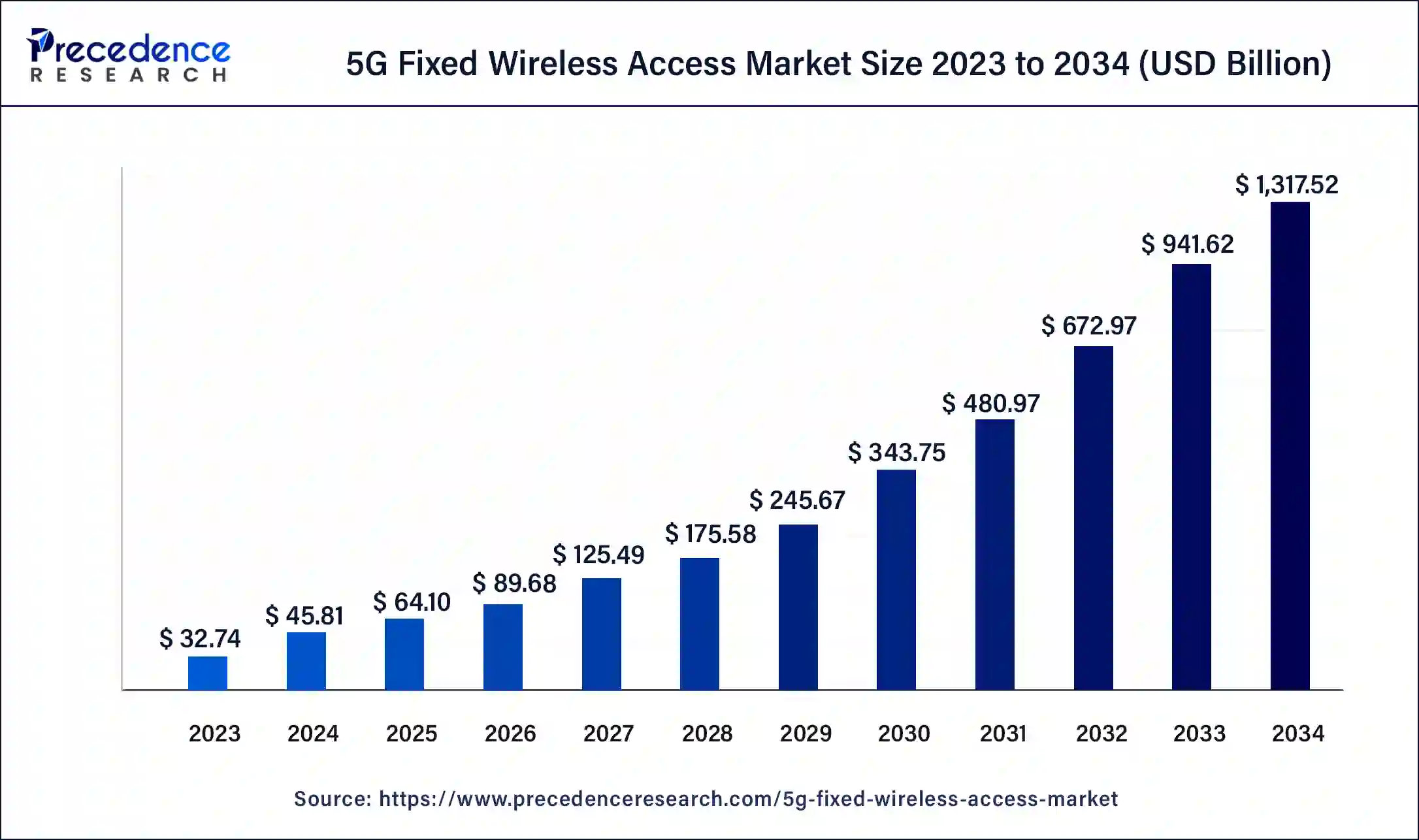
5G Fixed Wireless Access Market Key Takeaways
- In terms of revenue, the 5G fixed wireless access market is valued at $64.10 billion in 2025.
- It is projected to reach $1,317.52 billion by 2034.
- The 5G fixed wireless access market is expected to grow at a CAGR of 39.92% from 2025 to 2034.
- North America dominated the global 5G fixed wireless access market with the largest market share of 36% in 2024.
- By offering, the services segment has contributed the biggest market share of 65% in 2024.
- By offering, the hardware segment is anticipated to show considerable growth in the market over the forecast period.
- By operating frequency, the sub-6 GHz segment accounted for the largest market share of 50% in 2024.
- By operating frequency, the 24-39 GHz segment is projected to witness significant growth in the market over the forecast period.
- By demographic, the urban segment has contributed more than 56% of market share in 2024.
- By demographic, the semi-urban segment shows notable growth in the market during the forecast period.
- By application, the residential segment has generated the highest market share of 35% in 2024.
- By application, the commercial segment is projected to grow fastest during the forecast period.
How Can AI Help the 5G Fixed Wireless Access Market?
AI is leveraged to tackle the network traffic of the 5G fixed wireless access market and predict some simple working such as intelligent inferences for finding cell outages, which assist the network system configuration change, etc. It will also increase the proactive handover needed to supervise life-threatening emergencies where patients are treated through video conferencing/voice communications and avoid service disruption or at time of switchover connections from one cell tower onto another while care professionals aboard an ambulance on their way towards hospitals.
The 5G fixed wireless access market will help develop an eco-system, where the cloud-enabled processes and devices are driven by data-driven algorithms using cutting-edge AI and 5G technologies to deliver a mesmerizing experience to its consumers. 5G wireless networks can provide a superior Quality Experience 24/7 but will need to leverage AI. The 5G network boosts the performance of AI playing analysis, reasoning, and data fitting and clustering to improve outcomes in terms of consistency and success.
5G Fixed Wireless Access: Expected to Rehape Last-Mile Connectivity by 2025
The 5G Fixed Wireless Access (FWA) market is experiencing rapid demand, and telcos are recognizing last-mile delivery alternatives to fiber. In 2024, Verizon extended its 5G Home Internet rollout to over 60 U.S. cities, showcasing a growing trend of more people adopting home broadband consumption. The adoption of FWA services will be due to low costs to deploy and the high pace of urban growth and rural expansion. In 2025, emerging markets (e.g., India, Brazil) are rolling out FWA on large-scale efforts to diminish the digital divide. 5G FWA, when combined with edge computing infrastructure and mmWave capacity, will provide a new standard of broadband access in underserved markets globally.
Market Overview
Fixed wireless access, which can support 5G technology, is the next generation of wireless connectivity, offering the potential for ultra-high speeds, low latency, and massive capacity. FWA broadband technology is an essential tool in connecting the digital divide. Broadband connectivity is recognized as a vital enabler of economic and societal well-being and, increasingly, a significant contributor to environmental sustainability targets.
5G Fixed Wireless Access Market Growth Factors
- Rising demand in residential and commercial sectors for faster, reliable, and high-speed connectivity is driving the 5G fixed wireless access market.
- Lower infrastructure costs, compared to traditional wired networks, have driven the growth of the 5G fixed wireless access market.
- Advancements in 5G technology offering higher speed with lower latency positively impact growth of the 5G fixed wireless access market.
- Providing internet connectivity in rural as well as remote regions.
Market Scope
| Report Coverage | Details |
| Market Size by 2034 | USD 1,317.52 Billion |
| Market Size in 2025 | USD 64.10 Billion |
| Market Size in 2026 | USD 89.68 Billion |
| Market Growth Rate from 2025 to 2034 | CAGR of 39.92% |
| Largest Market | North America |
| Base Year | 2025 |
| Forecast Period | 2025 to 2034 |
| Segments Covered | Offering, Operating Frequency, Demography, Application, and Regions |
| Regions Covered | North America, Europe, Asia-Pacific, Latin America, and Middle East & Africa |
Market Dynamics
Drivers
Rising demand for high-speed connectivity
5G FWA provides high-speed internet comparable to traditional fixed-line broadband, thus making it an attractive option for urban as well as rural areas where laying down fiber infrastructure could be costly or time-consuming. Helped by the increase in remote workers and online tools for collaboration, reliable internet has been front of mind as employees need quick, low-latency connections to remotely access corporate networks and participate in video conferences. With technology advancing and businesses relying heavily on the internet, it appears likely that high-speed connectivity will only increase in demand. This drives the growth of the 5G fixed wireless access market.
- According to Ericsson's Fixed Wireless Access Insights, FWA connections are projected to grow significantly, reaching 330 million by 2029. This will constitute 18% of all fixed broadband connections and generate approximately USD 75 billion in revenue for service providers.
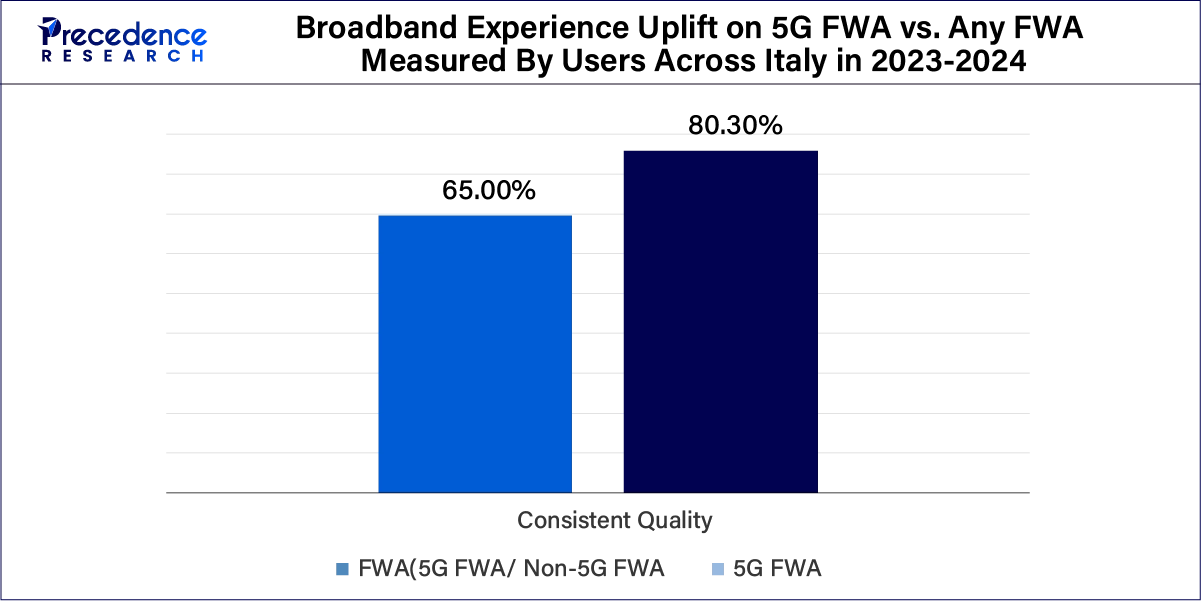
Restraint
Limited Coverage
5G wireless access points can have limited reach and may face interference, requiring them to be placed closer together than previous wireless technologies. This is because 5G wavelengths cannot penetrate walls. The high-frequency millimeter waves used in 5G have a narrow range and can be obstructed by buildings and other physical barriers. Fixed wireless access (FWA) units require line-of-sight connectivity to each other or the tower. The coverage will also be consistent since the router remains stationary, limiting the growth of the 5G fixed wireless access market.
Opportunity
Strategic partnerships
As in most industries, especially the information and communications technology (ICT) sector, the relationship between 5G FWA market players is mutually beneficial and based on the joint expansion of possibilities and networks. This means that telecom operators can lease the required consumer access from the ISPs to push high-speed services and coverage into the presently uncovered regions, and the technology vendors and equipment manufacturers could join efforts to key in the required structures. The real estate developers, the 5G FWA, can be incorporated into new buildings, making the properties attractive and connected. These create new opportunities for players in the 5G fixed wireless access market.
Further, affiliations with cloud service providers can provide the companies with bundled services involving internet connectivity and cloud services, and local governments can engage 5G providers to advance smart cities and improve the digital divide. These collaborations are effective at advancing technology and improving the effective use of resources and customer service at lower costs. This opens an opportunity for the growth of the 5G fixed wireless access market.
- In February 2023, Nokia and China United Network Communication Group Co. (CUC) announced an alliance for trailing a 5G fixed wireless access (FWA) solution based on Nokia's converged Multi-Access Gateway in the existing network (Guangdong). This is the first such test in the China market. By seamlessly integrating the fixed and mobile networks, CUC will be able to scale network bandwidth and deliver more broadband services to its customers in the future through its 5G network.
Offering Insights
The services segment has contributed the largest share of the 5G fixed wireless access market in 2024. With 5G wireless home broadband, homes and small businesses can avail of media-rich services, with a very low latency. 5G makes available a level of performance that will facilitate demanding fixed connections to perform over cellular and IoT traffic to increase significantly. 5G can be used for connected services, which are of three types Enhanced mobile broadband, massive IoT, and mission-critical communications.
The hardware segment is anticipated to show considerable growth in the 5G fixed wireless access market over the forecast period. 5G FWA is generally offered by operators. It can be a device, router, or modem, integrated with 5G FWA. 5G CPE is a terminal device used for access and connection to the 5G network. It can be a router, modem, or mobile device that supports 5G.
The services segment accounted for the dominating share of 65.00% in 2024. With 5G wireless home broadband, homes and small businesses can access media-rich services with very low latency. 5G makes available a level of performance that will facilitate demanding fixed connections to perform over cellular and IoT traffic to increase significantly. On the other hand, the hardware segment is anticipated to show considerable growth in the 5G fixed wireless access market over the forecast period. Operators generally offer 5G FWA. It can be a device, router, or modem, integrated with 5G FWA. 5G CPE is a terminal device used for access and connection to the 5G network. It can be a router, modem, or mobile device that supports 5G.
Operating Frequency Insights
The sub-6 GHz segment accounted for the largest share of the 5G fixed wireless access market in 2024. 5G networks are mainly focused on sub-6GHz bands, because of the shorter transmission distance and lower penetration of mmWave. Sub-6GHz bands will continue as the most popular choices for most telecom operators, while mmWave will be mostly utilized for data-showering hotspots such as packed stadiums or the real-time streaming and uploading of 4K/8K videos. 5G in mid-band spectrum (2 GHz to 6GHz) is considered to be ideal for FWA service and it gives 10 times the capacity to that of 4G.
The 24-39 GHz segment is projected to witness significant growth in the 5G fixed wireless access market over the forecast period. 5G mmWave bands provide high-bandwidth capacities, which is useful in settings with a lot of users, such as in stadiums. In telecommunications, mmWaves are used for high-bandwidth WLANs and short-range personal area networks.
The sub-6 GHz segment held the major market share of 50% in the 5G fixed wireless access market. 5G networks are mainly focused on sub-6GHz bands, because of the shorter transmission distance and lower penetration of mmWave. Sub-6GHz bands will continue as the most popular choices for most telecom operators, while mmWave will be mostly utilized for data-showering hotspots such as packed stadiums or the real-time streaming and uploading of 4K/8K videos.
Demography Insights
The urban segment dominated the 5G fixed wireless access market in 2024. Urban areas are characterized by high population density and residential, commercial, and other non-residential urban land uses. It is a place where the majority of national governments and countries house the biggest cultural, political, and economic centers are located. Urban environments have a relatively higher cable and fiber presence leading to speed differentials compared to rural.
- According to the UN, 68% of the world's population will be in cities by 2050. City governments and businesses are heading towards 5G, AI, and IoT technologies for creating smart cities where sensors, cameras, and smartphones will be connected; the connectivity and speed of these networks will let to better run the cities and be more efficient and sustainable.
The semi-urban segment shows notable growth in the 5G fixed wireless access market during the forecast period. The major benefit of FWA it does not require any cables or wires to be installed. This means that it can be installed rapidly and easily, even in remote areas, making it an excellent option for semi-urban areas. Additionally, fixed wireless internet can provide high-speed internet connectivity, with speeds that allow users to stream, work, and play games. Since it does not require any cables or wires to be installed, it is generally cheaper than DSL Internet.
Application Insights
The residential segment held the highest share of the 5G fixed wireless access market in 2024. The need to provide low-cost, high-speed internet to resident users has created a way of developing FWA technologies over 5G. Telephone and broadband services can be made available to a household using an indoor or outdoor subscriber unit and by running new 5G technology to connect the subscriber unit to the wireless network. Led by the development of mobile internet, online video, HD video, voice, home broadband, smart homes, and other entertainment. The enterprise segment is also anticipated to grow at a very high rate due to the use of 5G FWA for enterprise broadband, especially for remote working, industrial uses, and cloud services.
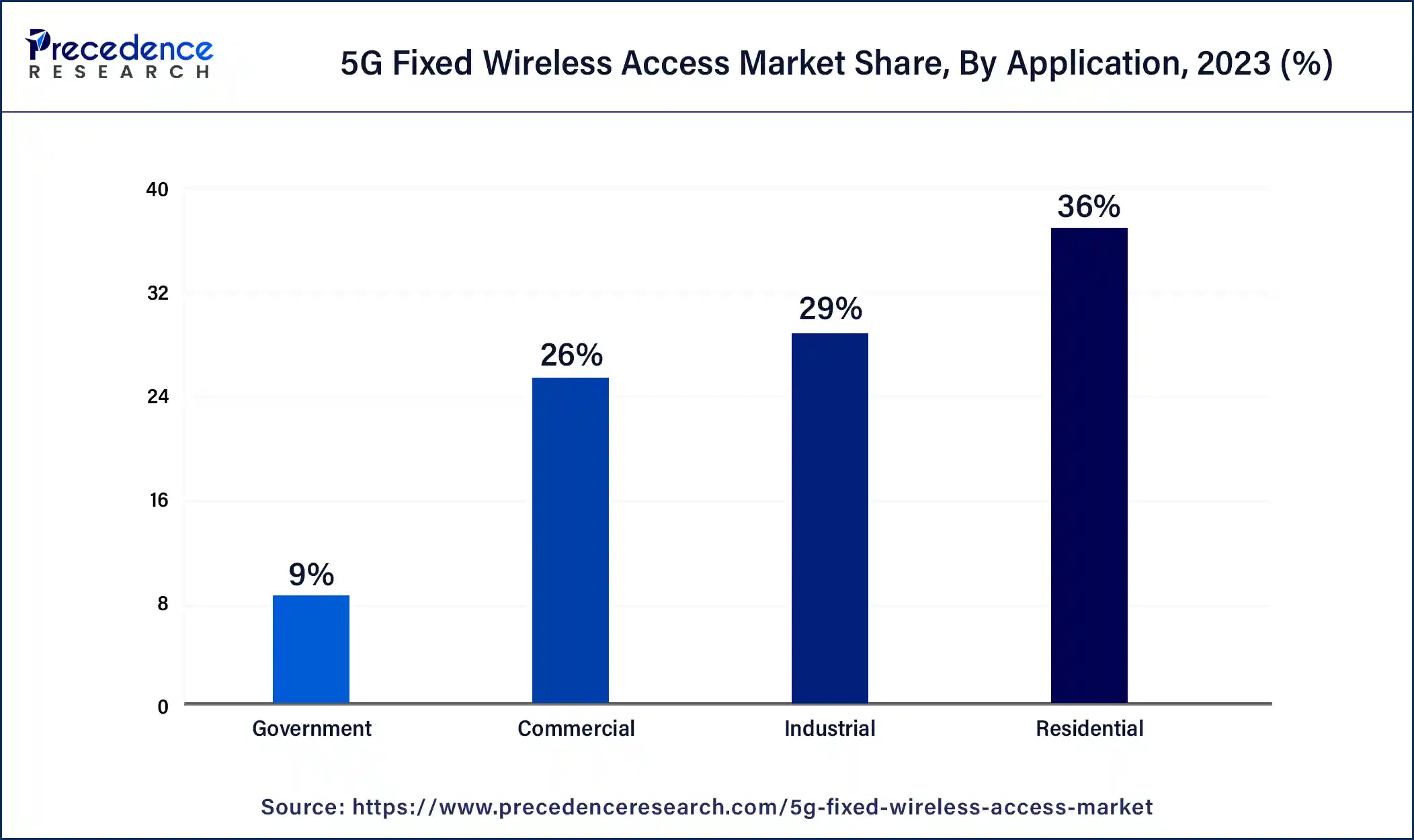
The commercial segment is projected to grow at the fastest rate in the 5G fixed wireless access market during the forecast period. As for the consumers, the need for fast Internet connection for online gaming, video streaming, and smart home applications is driving the adoption of 5G FWA as a reliable and fast Internet option. In the business segment, several industries like manufacturing, logistics, transport & healthcare are leveraging 5G FWA for the required connectivity to support the next level of application and improve operational efficiency.
- In July 2024, Forbes reported that as of 2024, 12.7% of full-time employees in India work from home, while 28.2% work a hybrid model.
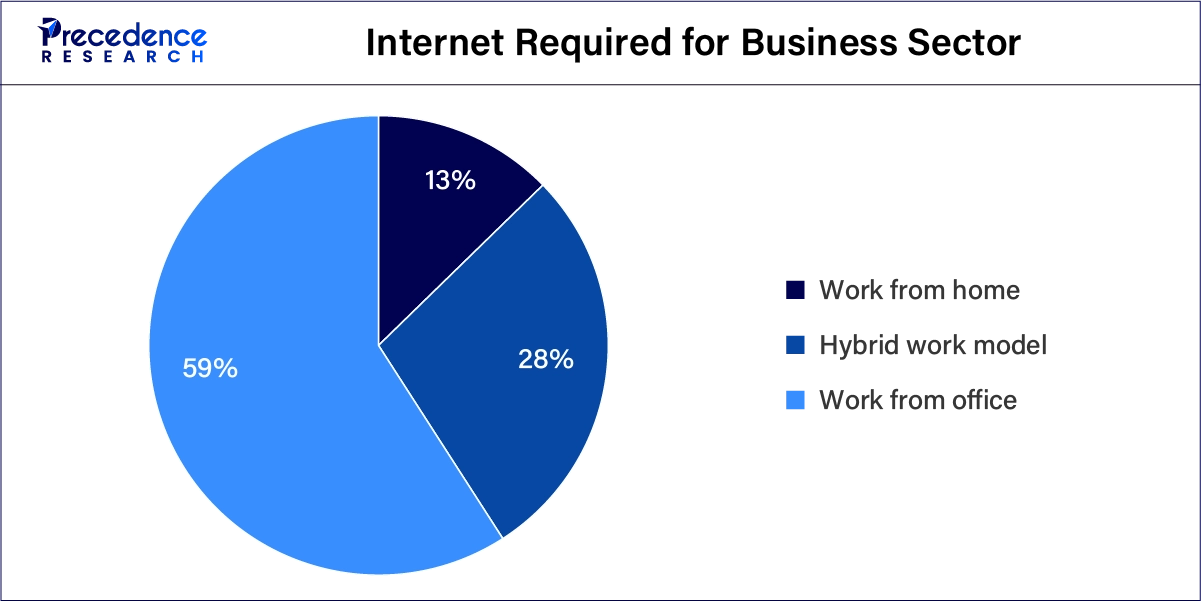
End user Type Insights
The residential segment held a dominant presence in the market in 2024, with 35.00%. The increasing need to provide low-cost, high-speed internet to residential users has created a way of developing FWA technologies over 5G. Telephone and broadband services can be made available to a household using an indoor or outdoor subscriber unit and by running new 5G technology to connect the subscriber unit to the wireless network. Led by the development of mobile internet, online video, HD video, voice, home broadband, smart homes, and other entertainment. On the other hand, the commercial segment is projected to grow at the fastest rate in the 5G fixed wireless access market during the forecast period. In the business segment, several industries like manufacturing, logistics, transport & healthcare are leveraging 5G FWA for the required connectivity to support the next level of application and improve operational efficiency.
Deployment mode Insights
The outdoor deployment segment accounted for the largest share of 54.30% in 2024. Outdoor deployments are generally favored for better performance. Placing antennas outdoors provides better connectivity, a higher range, and improved service. In addition, the integration of technologies like AI and edge computing is driving the segment's expansion in the coming years. Supportive government initiatives and increasing investment in broadband infrastructure to bridge the digital divide and significantly promote economic development.
Application Insights
The broadband internet access segment registered its dominance with 38.70% over the global 5G fixed wireless access market in 2024. The growth of the segment is driven by the increasing demand for stable and higher bandwidth to meet growing needs for data and connectivity. The expansion of smart city projects, rapid technological innovations in 5G technology, such as the use of millimeter-wave (mmWave) spectrum, advanced MIMO, and network slicing, and increasing adoption of remote work and online education are anticipated to propel the growth of the segment during the forecast period.
Regional Insights
U.S. 5G Fixed Wireless Access Market Size and Growth 2025 to 2034
The U.S. 5G fixed wireless access market size is exhibited at USD 16.35 billion in 2025 and is projected to be worth around USD 343.18 billion by 2034, poised to grow at a CAGR of 40.22% from 2025 to 2034.
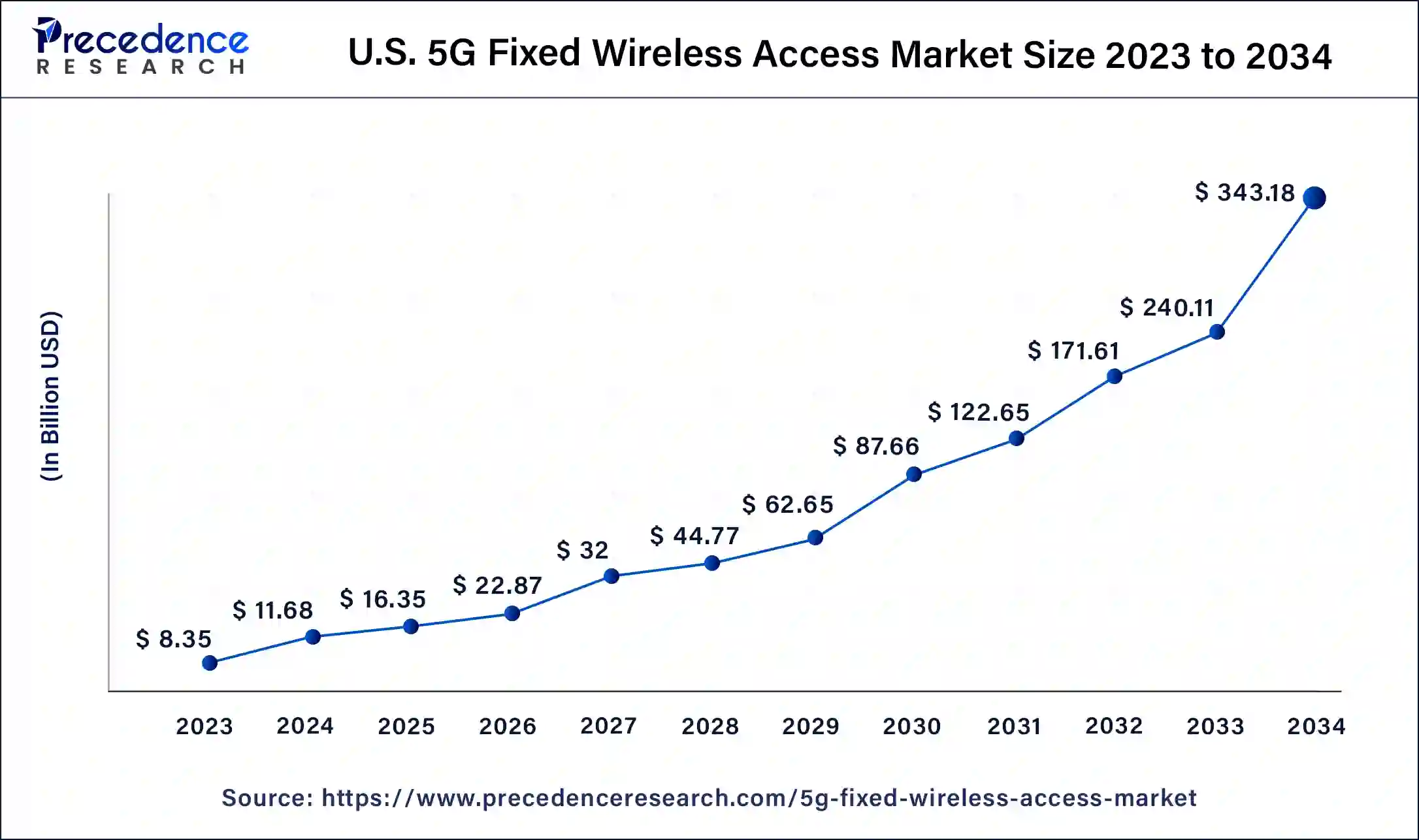
North America held the largest share of the 5G fixed wireless access market in 2024. The United States is replicating the private-sector-driven approach that saw the country to the 4G dominance to maintain this leadership in the 5G world. The method allows operators to make their own decisions about deployment which fuels competition and ultimately drives the innovations as well as investment.
There is a strong investment in 5G infrastructure by the dominant telecom players including Verizon, and T-Mobile which tend to FWA adoption and fill the internet availability divide. Besides this, the consumer demand for faster and more reliable Internet services is noted as more people stay and work from home.
- In May 2022, the U.S. government launched the Internet for All initiative. These programs will provide more than $48 billion for infrastructure deployment, skills training, and access to technologies essential for Americans to connect with their communities, their democracy, and one another.
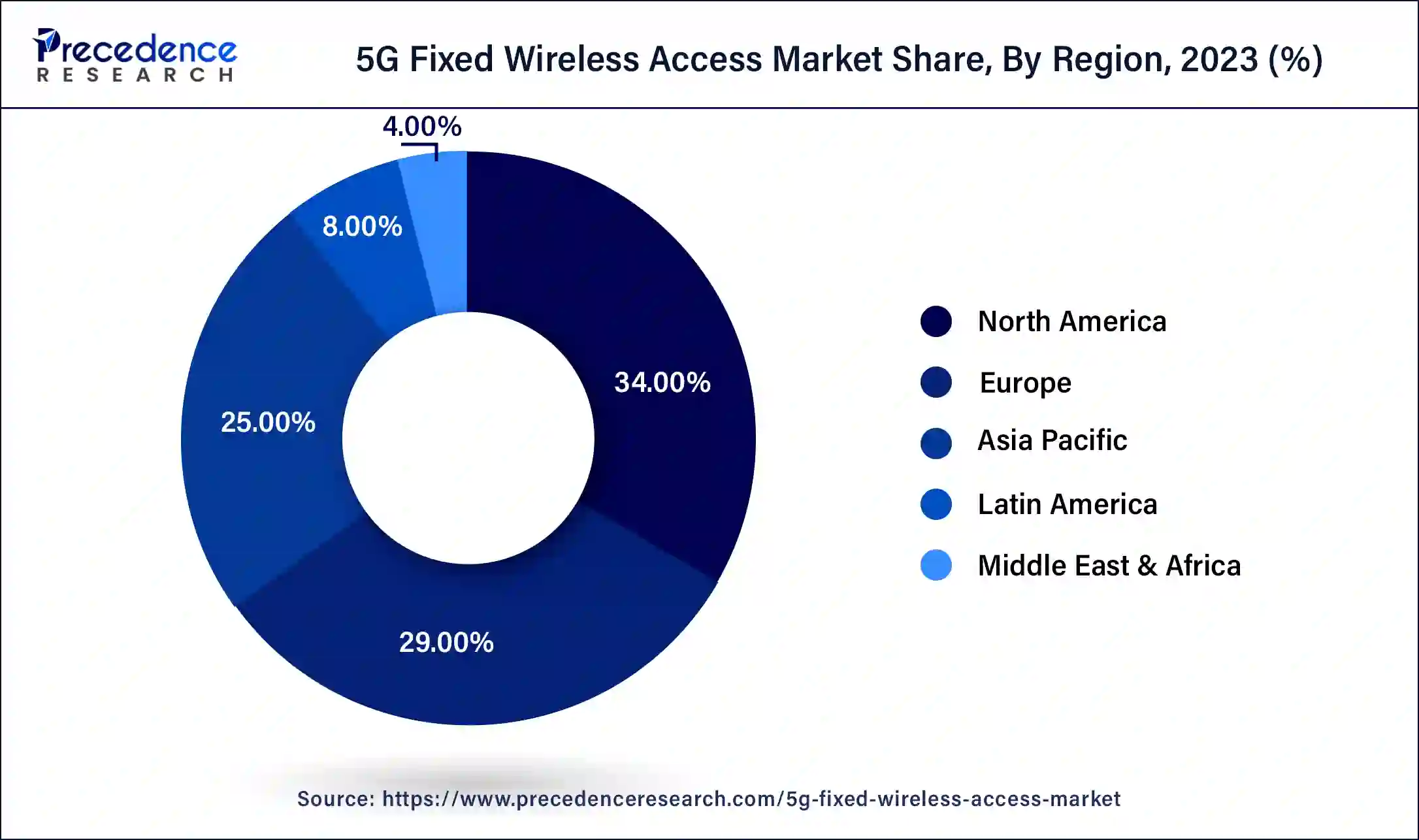
Asia Pacific is observed to witness the fastest rate of growth in the 5G fixed wireless access market during the forecast period. In developed markets such as China, South Korea, and Japan, the demand for high-speed internet is met through FWA since there is a high enthusiasm for adopting new technologies. Likewise, in emerging markets such as India and the rest of Southeast Asia, FWA is used to extend broadband internet to remote areas as a cheaper substitute for fixed broadband.
China is the largest mobile market in the world and is forecasted to overtake all the other markets and become the largest 5G connections market by 2025. In India, fast growth and the incredibly massive size of its connectivity market will be even more of a benefit with the rise of 5G, which makes it one of the most crucial areas for connectivity players.
- According to a GMA report, it emerged that, in the Asia Pacific region, approximately 50% of the total population is connected to the mobile internet. The mobile internet usage gap in the region has narrowed significantly from 60% in 2017 to 47% in 2022 due to improvements in the affordability of the devices and improvements in digital skills. Also, the use of the Internet in many activities in society has increased in recent years.
- According to a GMA report, Asia Pacific had 1.36 billion mobile internet subscribers in 2022.
5G Fixed Wireless Access Market Companies
- Huawei technologies co., ltd.
- Telefonaktiebolaget lm ericsson
- Nokia
- Samsung
- Inseego Corp.
- Qualcomm Technologies, inc
- Intel Corporation
- Mediatek inc.
- Commscope
- Verizon Communications Inc.
Recent Developments
- In May 2025, Fibocom, a global leading provider of wireless communication modules and AI solutions, announced the launch of its 5G module FG390, developed on the advanced MediaTek T930 platform. Designed for mobile broadband (MBB) terminal products focused on 5G Fixed Wireless Access (FWA), the FG390 series seeks to boost FWA industry growth across diverse applications such as CPEs, ODUs, mobile hotspot devices, enterprise gateways, and industrial gateways. (Source: https://www.thefastmode.com)
- In May 2025, Nokia and Three Sweden (Hi3G Access AB) expanded access to fast broadband through 5G Fixed Wireless Access for improved connectivity. With Nokia's FastMile 5G Gateway 2, users will benefit from easier access to reliable, high-speed internet where fiber is not available or would be too expensive to deploy. (Source: https://www.manilatimes.net)
- In February 2025, Radisys Corporation, a global leader of open telecom solutions, announced the availability of its 3GPP Release 18-compliant 5G Multi-RAN software suite, setting a new industry benchmark for ubiquitous connectivity. This next-generation 5G RAN solution is designed to seamlessly integrate terrestrial, non-terrestrial (NTN), and non-3GPP access networks. Includes 5G Integrated Access and Backhaul (IAB) for cost-effective, high-performance networks in fiber-scarce environments via 5G wireless backhaul service relay nodes as 3GPP compliant Donor CU and Donor DU. (Source: https://www.businesswire.com)
- In July 2024, Costa Rican company Radiografica Costarricense SA (RACSA, a Grupo ICE company) launched 5G fixed wireless access (FWA) services on the market, supported, it says, by the country's first and only network designed for this technology. RACSA is promoting its 5G wireless internet services to interested organisations and companies on its website, where they are invited to enquire about the service. (Source: https://developingtelecoms.com)
- In August 2024, Brisanet launched 5G FWA services in northeast Brazil.
- In December 2023, HFCL launched its indigenously designed and developed 5G fixed wireless access consumer premises equipment (CPE) for telecom operators.
- In January 2023, Mavenir launched a fixed wireless access (FWA) solution that supports 5G non-standalone (NSA), 5G standalone (SA), and 4G deployments. That FWA system also supports massive multiple input multiple output (MIMO) radio technology and 5G millimeter wave frequency bands.
- In September 2022, Nokia and Telia Finland launched the world's first commercial 5G SA network with network slicing for fixed wireless access.
Segments Covered in the Report
By Offering
- Hardware
- Customer Premises Equipment (CPE)
- Indoor CPE
- Outdoor CPE
- Access Points / Base Stations
- Antennas
- Routers & Modems
- Customer Premises Equipment (CPE)
- Services
- Installation & Integration
- Network Planning & Optimization
- Support & Maintenance
- Platform / Software
- Network Management Software
- Security Solutions
- Spectrum Management Tools
By End User Type
- Residential
- Urban Households
- Suburban & Rural Households
- Commercial
- Offices & Enterprises
- Retail Chains
- Hospitality
- Industrial
- Manufacturing Units
- Energy & Utilities
- Oil & Gas Fields
- Government & Public Sector
- Smart Cities & Municipal Services
- Defense & Security Networks
- Educational Institutions
By Deployment Mode
- Indoor Deployment
- Outdoor Deployment
- On-Premise FWA
- Cloud-Hosted/Edge-Based Deployment
By Application
- Broadband Internet Access
- Urban Connectivity Enhancement
- Rural/Remote Area Coverage
- IoT Connectivity
- Video Streaming and OTT Services
- Smart Home/Smart Building Applications
- Backup and Redundancy for Wired Networks
- Enterprise WAN/Branch Office Connectivity
By Geography
- North America
- Asia Pacific
- Europe
- Latin America
- Middle East & Africa
For inquiries regarding discounts, bulk purchases, or customization requests, please contact us at sales@precedenceresearch.com
Frequently Asked Questions
Ask For Sample
No cookie-cutter, only authentic analysis – take the 1st step to become a Precedence Research client
 sales@precedenceresearch.com
sales@precedenceresearch.com
 +1 804-441-9344
+1 804-441-9344